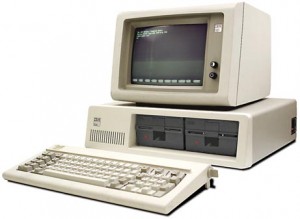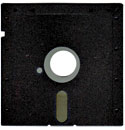The following items are excerpts from a newsletter published from January 1984 through December 1989 by Abacus Programming Corporation. Pono was the reporter and editor. Although it wasn’t THAT long ago, in reviewing these artifacts I was shocked at the number of things (companies, products, concepts, publications) that flashed briefly and then disappeared. Those were truly dynamic years!

In 1983, Abacus continued exploration and development in the area of IBM PCs. This is the first in a series of monthly newsletters intended to help advise Abacus friends on PC related topics and keep them informed of Abacus capabilities and resources. …….
· losing a day. We have both AST and Techmar Multifunction boards with clocks. Neither one handled February 29. (March 1984)
· using a very helpful hint. Remember when PC World included a demo of Microsoft WORD in one of its issues. The hint that came with that diskette said that if you get errors using it, it may not be spinning freely in its jacket. To correct this you need to flatten the edges of the jacket, raising the jacket walls away from the disk surface. Grasp the disk by two corners and firmly draw each edge of the jacket across the edge of a desk (as if you were sawing the desk with the disk). Take care when passing notches. This hint has salvaged many “bad” diskettes that were probably just squashed in packing, shipping, or even storage. (June 1984)
· taking delivery on a PC AT. It just popped out of the box so we don’t have much to say yet. The back panel has references to 250 V that are confusing and of course configuration control becomes more complicated with DOS 3.00, BASIC 3.00, and high capacity (1.2Mb) floppies. (September 1984)
· enjoying PC Week. In the world of PC information, a standout in timely, substantial reporting is PC Week, “The national newspaper of IBM standard micro computing”. (January 1985)
· avoiding vacuum cleaners. We have it on good authority that it is advisable not to keep diskettes or other magnetic media in bottom desk drawers. It seems that the magnetic field generated by a vacuum cleaner can zap them. (April 1985)
· giving our neighbors something to think about. Early television shows should be reaching star systems nearest to us just about now. Do you think they will understand Uncle Miltie and Howdy Doody? (May 1986)
· mourning monochrome departure. We constantly tell the fearful (newcomers to the micro world, kids, etc.) to try anything they want with the computer short of physical abuse. You can’t hurt anything with keystrokes, right? Wrong! We may never truly understand this one, but the bare facts are: running IBM diagnostics on a PC with a very early model Hercules graphics board, 640Kb memory, and a monochrome monitor, resulted in destruction of the monitor. Abacus blames fate. (September 1986)
· rejecting inversion. After observing that the Okidata printer uses only the top half of its ribbon, it seemed logical just to reverse the reels when the listings started getting light. The result was disappointing. Apparently the ink on the unused side either dries out or soaks into the used area. Reversing the reels was not worth the time. (October 1986)
· keying frustrations. Using SuperKey (Borland Int.) can really help when one is repeatedly entering the same string of characters. In a user’s guide we needed to type the string <ENTER> many times so it was defined as a macro. Guess what? That’s how you tell SuperKey to output an ENTER code. (November 1986)
· developing a new product. Our R&D staff is working out the kinks in the newest addition to our PC Helper series. This item is an L-shaped lever that slips under the right side of your system unit. In operation, one presses the long arm which results in raising the system unit about two inches in the air. At that point the lever slips off and the system unit drops back to the table, resetting the hard disk. This product is the result of a reader’s report that his PC’s Limited machine could not find the hard disk one day. He called for help and they recommended that he remove the disk and strike it sharply. It seems that the disks they use are self parking and sometimes do such a good job that they get stuck. Many times the return trip shipping has fixed the problem! (December 1986)
· leasing made easy. In what could be the start of a marketing trend, Lincoln-Mercury is offering a free diskette containing “Facts and benefits … so you can learn before you lease … your next car.” This free diskette is available from an 800 number for the IBM, Apple, Commodore, or Rainbow (what are those last three things?). (May 1987)
· making NASA’s list. The Abacus creators of the PC based Mission Manager’s Workstation (produced for Rockwell International) received a commendation and a monetary award for their innovative work. You can read about the new MMW in a future issue of NASA Tech Briefs (published monthly by NASA) or call Abacus for a copy of a paper on the subject. We are proud of our award winners! (May 1987)
· programming a yard. This writer just had an irrigation system put in at home and was told by the contractor that the maintenance gardener would probably be able to set it up for changing seasons and needs. Feeling challenged, I found that while the user interface leaves a lot to be desired, it was possible to program the device with the usual trial and error and “last known bug”, and we now have quite a water show at 3:30 in the morning. (May 1987)
· hitting heights and pits. While working at home the other night, my 14 year old came in with a friend I hadn’t met before. He saw me at my PC and said “WOW!”. I imagined that he was impressed by a man on the forefront, with automation in the home, etc. and was pleased. He walked up to me and the machine and repeated “WOW, that’s ancient! I don’t see many full height floppy drives these days.” It turns out he assembles clones at a summer job. Oh, well. (August 1987)
|
|
^5.25” floppy <<< IBM PC with 2 full height floppy drives |
· getting a bargain? Always in a mood for low prices, we tried 200 diskettes from Micro Center/MEI in Columbus, Ohio, for a total of $55. The diskettes were delivered in plastic bags of 25 each, with sleeves in bulk form included. In one batch of 25, only 8 formatted without bad sectors. Discolored spots on the diskettes were easy to see. The real bargain appeared when one of the diskettes produced a “drive not ready – format failure”. It turned out to have two diskettes in one envelope! (October 1987)
· seeing why Blue is BIG! Remember the failed AT hard disk that we took apart for learning? In response to the letter to IBM complaining about the dust and debris inside the compartment, we received several phone calls from IBM reps up to the VP level with explanations and apologies. They admitted a design flaw in the filter mechanism and actually sent us a replacement disk even though we are clearly out of warranty. (October 1987)
· finding it hard to believe. A machine developed by 3D Systems, Inc. comes as close to magic as anything we’ve seen lately. This device can produce models of small parts directly from the computer aided design (CAD) system. The process is called stereolithography. The following is quoted from the November issue of Managing Automation. “The . . model . . is converted by software to a series of cross sections. Each one is then traced on the surface of a vat of liquid photoplastic by an ultraviolet laser, which hardens the plastic in the form of the part. The process is repeated, building the part up layer by layer like a cake, until it emerges from the vat some minutes or hours later.” An elevator platform supporting the part is lowered a fixed distance into the vat for each layer. Nothing is perfect, though. They admit “the models are precise only to about 0.005 inch.” (November 1987) (Note – see the contemporary capability at http://www.youtube.com/watch?v=zCi-lXN28x0)
· drying diskettes. The heavy rains got through the fragile roof of our offices in Van Nuys and inundated a diskette file. We spread out the wet ones, dried them with a fan and successfully read every one. Others with this problem have reported taking the disk out of the protective envelope, drying it, putting it in a new, dry envelope and successfully reading it. (November 1987)
· detecting infiltration. Perhaps from a false belief that it raises the status of the activity, perhaps in an attempt to be creative, or perhaps from simply not knowing what is correct, there is a growing tendency to call “one that does xxx” an “xxxor”. So we see words like documentor, implementor, and parsor creeping into the literature. Of course, English exceptions like processor, professor, and manipulator only serve to complicate the mattor. There ought to be a terminator detector, predictor, differentiator, and corrector – is thore? (July 1988)
· bashing keyboards. We know that anyone who takes the time to read PCNEWS is a mature, intelligent, sophisticated person capable of exercising good judgment and common sense. With this in mind the following secret is imparted. The first thing to try if your keyboard has problems like sticking keys is to turn it upside down and rap it sharply against a sturdy surface. You will be amazed at the crud that drops out, and it is very apt to fix the problem. (November 1988)
· panning hardware. We still enjoy the memory of the one word review in PC Magazine of a particularly bad piece of hardware. The word – “Landfill”. (April 1989)
Welcome to the June edition of PCNEWS (winner of the 1988 Touring Award and nominee for the 1989 Wurlitzer Prize). As you digest these items, keep remembering that you saw them here first. …
· analyzing cost/benefit. If cost per unit weight means anything, we got the best deal ever in the form of an upgrade from Microsoft Word version 4.0 (PC) to version 5.0. For $5.50 we received nearly 6 pounds of documentation, templates, letters and diskettes. To contrast, the original Word cost about $35 per pound, Norton was $40, and dBase IV was $34. (June 1989)
· saying farewell. Many factors have led us to a decision to cease publication of Abacus PCNEWS after six full years. This has been an enjoyable six years for us and we hope you have had a chuckle or two, picked up a pointer or two, had occasion to think favorably about Abacus, and perhaps seen things from a little different perspective. If so, our goal has been achieved. … Thank you for your participation, encouragement, and friendship. Farewell. (December 1989)
AFTERWORD
It was very difficult to subset the items from this six years of monthly publications. I had to keep restraining myself so as not to overtax the current attention span. Taken all together this collection is an outline of an exciting period from when the PC was introduced and as it quickly worked its way into the mainstream. It tracked prices of hardware, software and media as Moore’s law was observed. It mentioned names of software packages and their authors, hardware elements and their manufacturers, purveyors of HW and SW, publications relevant to the new field, and customers struggling to make sense of it all. Many of these names are long gone today, but the field continues to burgeon. I hope this brief subset gives you a bit of the flavor of the period, and for those who were a part of it, perhaps some memories.

